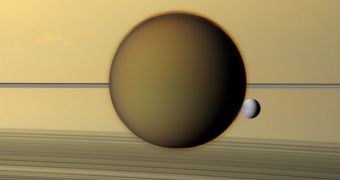Since it boasts one of the most complex chemistries in the solar system, the Saturnine moon Titan naturally captured the undivided attention of astronomers. Now, experts want to know how long it's been since the celestial body started producing methane.
Though similar to our own planet in many respects, the Saturnine moon differs from Earth through its chilly temperatures (averaging -170ºC or -270ºF) and the fact that all of its natural cycles are based on hydrocarbons, instead of water.
Vast amounts of methane and ethane rain down from the atmosphere, accompanied by lightning, and cover the surface with soot. At certain locations, primarily at the moon's poles, the chemicals accumulate into surface lakes of liquid hydrocarbons.
What planetary scientists and geologists are interested in learning is how Titan's atmosphere was turned into such a productive chemical factory, and also in how long this process has been going on. These data could then be put to use for explaining how the solar system and Saturn evolved.
Undoubtedly, the most important chemical element on the moon is methane, a molecule featuring four hydrogen atoms attached to a single carbon atom. Titan shouldn't theoretically have so much methane, since the chemical is easily destroyed by sunlight.
The process results in the formation of increasingly complex molecules. Two papers published in the April 20 issue of the Astrophysical Journal now attempt to provide an accurate estimate of how long the atmospheric chemical factory has been operating on the Saturnine moon.
These investigations were conducted using two instruments aboard the NASA Cassini spacecraft, which has been orbiting the gas giant since 2004. Some of the data in the study were taken from the information relayed back to Earth by the ESA Huygens probe.
The latter was ejected by Cassini, and landed onto the surface of Titan, back in January 2005. Using these three instruments, scientists were able to reveal that methane in the atmosphere is around 1 billion years old.
Weirdly enough, the age itself is not as important as learning that the gas started appearing on the moon long after Titan itself formed around Saturn. The last major methane eruption from the moon's interior is believed to have occurred between 350 million and 1.35 billion years ago.

 14 DAY TRIAL //
14 DAY TRIAL //